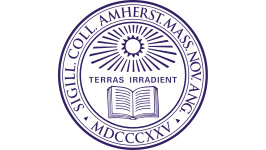Amherst College

Amherst College is a private liberal arts college located in Amherst, Massachusetts, United States. Founded in 1821 as an attempt to relocate Williams College by its president, Zephaniah Swift Moore, Amherst is the third oldest institution of higher education in Massachusetts. The institution was named after the town, which in turn had been named after Lord Jeffery Amherst. Amherst was established as a men's college and became coeducational in 1975.
Amherst is an exclusively undergraduate four-year institution and enrolled 1,795 students in the fall of 2015. Students choose courses from 38 major programs in an open curriculum. Students are not required to study a core curriculum or fulfill any distribution requirements and may even design their own unique interdisciplinary major. Freshmen may take advanced courses, and seniors may take introductory ones. For the class of 2020, Amherst received 8,397 applications and accepted 1,149 yielding a 13.7% acceptance rate. Amherst was ranked as the second best liberal arts college in the country by U.S. News & World Report, and 12th out of all U.S. colleges and universities by Forbes in their 2016 rankings. Amherst competes in the New England Small College Athletic Conference.
Amherst has historically had close relationships and rivalries with Williams College and Wesleyan University which form the Little Three colleges. The college is a member of the Five College Consortium, which allows its students to attend classes at four other Pioneer Valley institutions. These include Mount Holyoke College, Smith College, Hampshire College, and the University of Massachusetts Amherst.
Academics
Amherst College offers 36 fields of study (with 850 courses) in the sciences, arts, humanities, mathematics and computer sciences, social sciences, foreign languages, classics, and several interdisciplinary fields (including premedical studies) and provides an unusually open curriculum. Students are not required to study a core curriculum or fulfill any distribution requirements and may even design their own unique interdisciplinary major. Freshmen may take advanced courses, and seniors may take introductory ones.
Thirty-five percent of Amherst students in the class of 2007 were double majors. Amherst College has been the first college to have undergraduate departments in the interdisciplinary fields of American Studies; Law, Jurisprudence and Social Thought; and Neuroscience and has helped to pioneer other interdisciplinary programs, including Asian Languages and Civilizations.
The Amherst library is named for long-time faculty member, poet Robert Frost. Amherst College has been recognized for its commitment to quality teaching with professor-student interaction. The student-faculty ratio is 8:1 and 90% of classes have fewer than 30 students.
Notable faculty members include, among others, modern literature and poetry critic William H. Pritchard, Beowulf translator Howell Chickering, Jewish and Latino studies scholar Ilan Stavans, novelist and legal scholar Lawrence Douglas, physicist Arthur Zajonc, Pulitzer Prize-winning Nikita Khrushchev biographer William Taubman, African art specialist Rowland Abiodun, Natural Law expert Hadley Arkes, Mathematician Daniel Velleman, Biblical scholar Susan Niditch, law and society expert Austin Sarat, and Pulitzer Prize-winning composer Lewis Spratlan, professor emeritus of the music faculty.